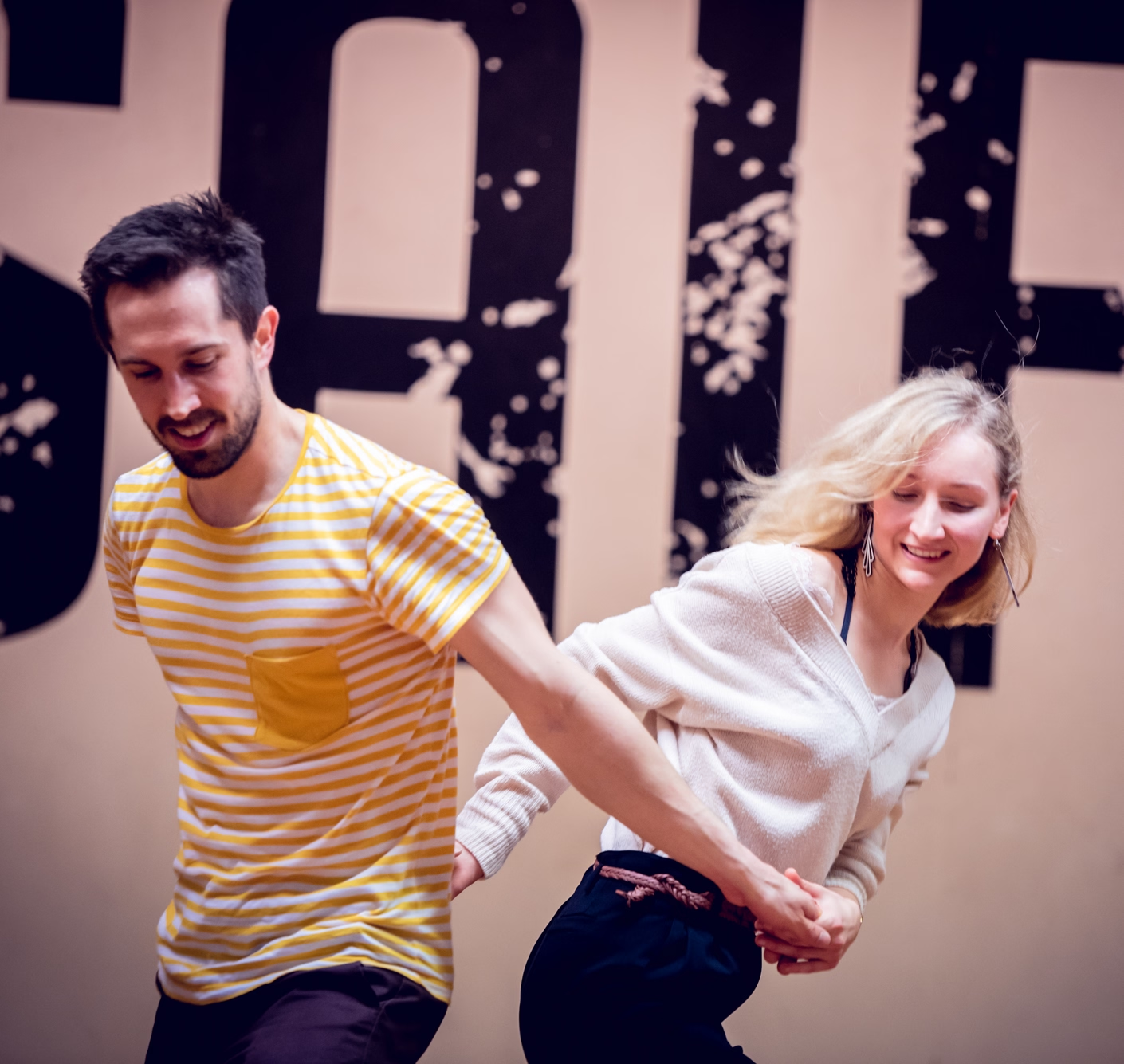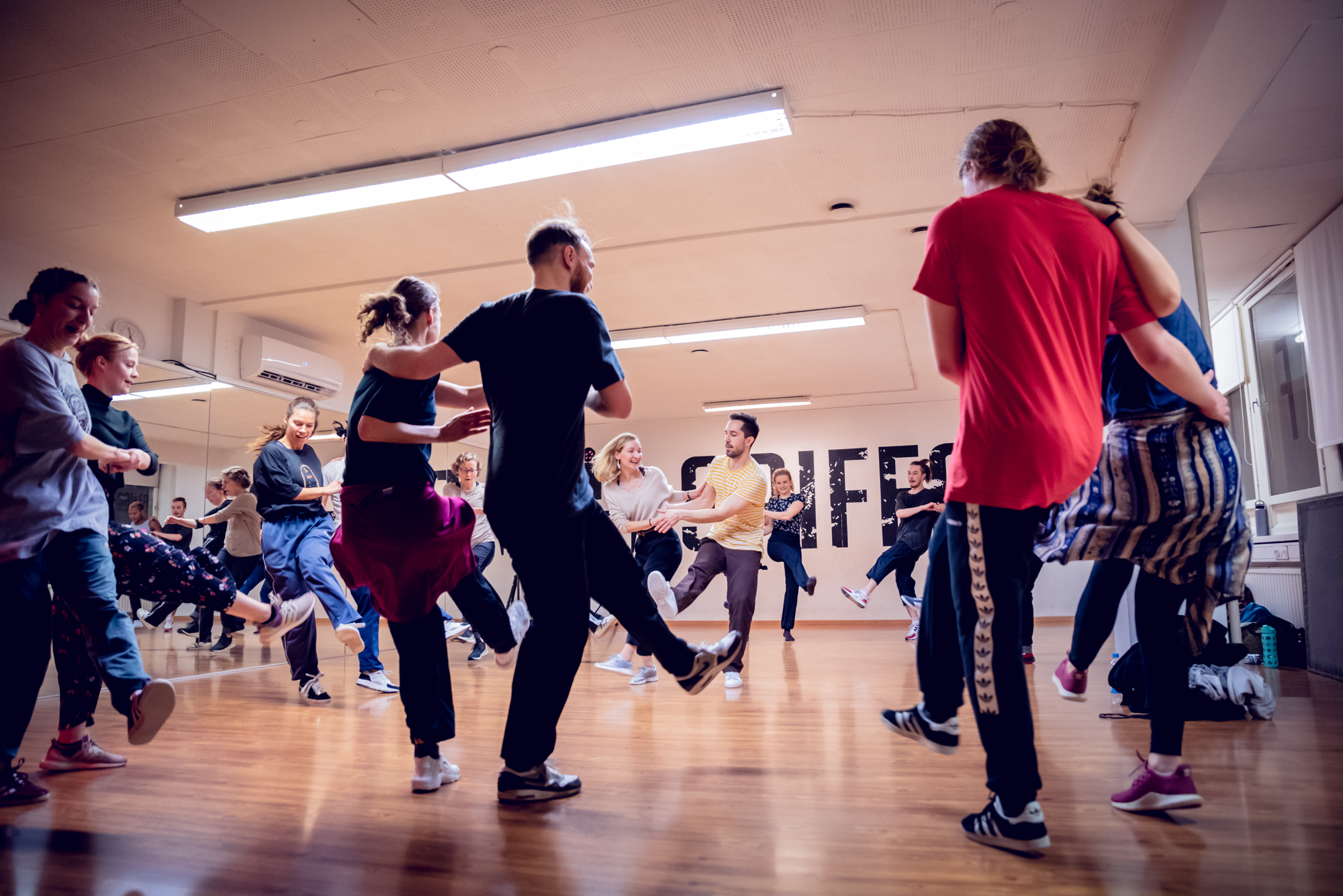Moi!

We are Tanja and Kay, two Swing- and Authentic Jazz dancers from Helsinki, Finland. We love anything Swing, and have been immersing ourselves in its vibrant culture for many, many years.
Between the two of us, we have around 15 years of combined experience teaching Lindy Hop and Solo Jazz. We're running regular weekly classes, teaching Lindy Hop in Helsinki, multiple themed workshops every year, and occasionally, we get invited to teach at international festivals, which seems positively crazy to us.
We also like hiking, climbing, pole dancing, and many other forms of movement. But always with a little Jazz.
Autumn Courses
Our autumn season starts on 28 August 2025. Registration opens on 20 May 2025. All our courses run for 16 classes à 70 min and are taught in English (though you can of course get clarifications in Finnish or even Swedish on a good day).
Schedule
Lindy Intermediate/Advanced (full)Thursdays, 18:30–19:40
Start: 28 August 2025
End: 18 December 2025
Break: 16 October 2025
Venue: Helsingin Astangajoogakoulu, Annankatu 29 B, 00100 Helsinki
Teachers: Tanja Wingerter & Kay Werndli
This level is best suited for dancers with 3 or (many) more years of experience. You have a firm grasp on the essential rhythms and shapes of Lindy Hop, and you can combine them easily; all while keeping good time while dancing. You are able to dance with and adapt to partners of different levels and to a wide variety of tempos.
This level will keep you challenged for many years, and we are happy to give you extra challenges if you long for them.
Lindy Intermediate, ELEF*Thursdays, 19:50–21:00
Start: 28 August 2025
End: 18 December 2025
Break: 16 October 2025
Venue: Helsingin Astangajoogakoulu, Annankatu 29 B, 00100 Helsinki
Teachers: Tanja Wingerter & Kay Werndli
This level consists of material that is best suited for Lindy Hoppers with at least 1 year of experience in both roles or 2–3 years of experience in one role. You know your 6-count, your 8-count, and you can dance common patterns on a range of tempos using triple steps or kicks. During the course, you will further improve your basics and tackle more complicated patterns. You will also expand your knowledge about the culture, as well as improve your awareness of your own movements, your partner, and the music.
Because in this course, everyone leads and follows, this can also be a good level for those who are already more advanced in their dominant role, but who would like to learn the other role as well without starting from 0.

Prices
A single course is 230 € (incl. 14% VAT). Every additional course is 10% off. If you're a student or unemployed, we will apply a 10% discount to the total amount.
Levels
We don't think it's possible or desirable to categorise dancers into strictly linear levels. Please use your best judgement, and take our level descriptions as what they are: guidelines. If you are uncertain, which level would be a good fit, drop us a line.
FAQ
Can I learn Lindy Hop without any prior dance experience?
Sure you can! Both of us started our own dance journey with Lindy Hop, and only later ventured into other styles to broaden our horizons. And while picking a partner dance to start with can be scary, we think Lindy Hop is a great choice. It offers an interesting balance between connecting with your partner and individual freedom. That way, you're not dancing on your own, but you're also not reliant on each other (or each other's levels) to have good dance.
In the end, the most important thing you should ask yourself is whether you like the music, and if it makes you feel like you want to move to it.
Do I need a partner to sign up for classes?
No, you don't; though you can sign up with a partner to make sure you both get into the course if there is enough space. During the class, however, we rotate partners regularly.
Can I dance with a fixed partner during class?
In our classes, everyone rotates partners unless explicitly stated otherwise in the course description. This creates a better class atmosphere and learning opportunities for everyone. That being said, if there are specific reasons preventing you from being able to rotate partners, please do get in touch in advance, and we will sort things out. Of course, if you're feeling uncomfortable dancing with a particular person during class, don't hesitate to let us know.
Are there any preferred roles?
The only preference that matters is your personal one. Anyone can choose to lead or follow, and while most people have a stronger role, it's very common to know at least the basics of both. All our students learn and practice both roles for the first year of taking classes.
What are ELEF classes?
ELEF stands for "everybody leads, everybody follows". It means that during class, we will switch roles regularly, and you get to practice your dancing both as a leader and as a follower.
Won't ELEF classes hold me back?
Anecdotally, it is true that when learning both roles, it takes a bit longer to get to the more complicated patterns. Also, learning two different sets of footwork in parallel can be confusing initially. However, in Lindy Hop, there is less emphasis on patterns. Instead, we value rhythm, individuality, and the connection with our partner a lot more.
We firmly believe that in the long run, learning both roles from the start will help your development. It leads to a better understanding of the dance, more empathy, and clearer communication with our partner.
What shoes do I need?
Different dancers have different preferences. Some people like to dance in sneakers, allowing for more grip and a more athletic style of dancing. Others prefer shoes with a leather or suede sole, for awesome slides. The latter also tend to be gentler on the knees.
Whatever your preference, make sure to bring a dedicated pair of indoor shoes, so the dance floor doesn't get wet or dirty.
What clothes should I wear?
That's really up to you and your personal style. For class, wear something that is comfortable and that you can move freely in. Some like to go for the vintage look, even for classes, while others prefer the comfort of sweat pants. For parties, people tend to dress up a bit more, but again, there's a whole spectrum: some go to parties wearing suits or dresses, others go for jeans and a t-shirt.
What if I miss a class?
Ideally, you'll let us know in advance, so we can try to take care of the role balance for courses that aren't ELEF. However, we understand that life sometimes gets in the way at the last minute, and that giving us a heads-up might not always be possible.
You can make up for missed classes by joining a class from another course that is suitable for your level.
About

Tanja started her Lindy Hop journey while on exchange in Ljubljana in 2014 and continued her new passion during further exchanges in Montpellier and Madrid (yes, she did 3 Erasmus exchanges…). In 2017, Tanja started teaching and never stopped since. Her biggest fascination in the dance is the music, and she is constantly on the hunt for new, wonderful tunes. People usually agree that her dancing is very elegant. In reality, she is a huge goofball who always tries to make her dance partner smile.
Kay was first introduced to Lindy Hop in 2014 while living in Bern, Switzerland. Soon after, he moved to Stockholm, which is where he truly discovered his passion for this dance, heavily influenced by the vibrant Swedish Lindy spirit. Later on, Kay started teaching in the Netherlands, before moving to Finland and starting to teach together with Tanja. To him, moving is pure joy, which is visible in his athletic style and the big smile he tends to have while dancing.
Our classes are more often than not energetic and fast paced. We especially value connecting the dance to the musical context and history. One of our most important focus points is that leaders and followers receive equal amounts of challenge and attention in class. You will never hear us say things like "just follow" or "it's always the leader's fault", because we have the most fulfilling dances when both partners can equally listen, initiate, and respond.
Contact

